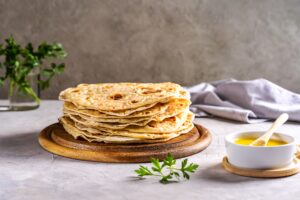 Chapati is a whole wheat, yeast-free flatbread and is a mealtime staple throughout India and beyond. Chapati is similar to a tortilla and can be paired with most meals or used as a wrap. This delicious recipe requires only four simple ingredients and can be made in less than 30 minutes. By using 100% whole wheat flour, you will find much more flavor and nutrients compared to its refined white flour counterpart.
Chapati is a whole wheat, yeast-free flatbread and is a mealtime staple throughout India and beyond. Chapati is similar to a tortilla and can be paired with most meals or used as a wrap. This delicious recipe requires only four simple ingredients and can be made in less than 30 minutes. By using 100% whole wheat flour, you will find much more flavor and nutrients compared to its refined white flour counterpart.
Whole wheat is considered cooling, strengthening, and energizing making it a great option for balancing Vata and Pitta, although Kapha types may be able to enjoy in moderation. I tend to limit my overall wheat consumption, but when I do “indulge”, I always use a high-quality whole wheat flour and opt for wholesome, homemade recipes such as this. By using these precautions along with moderation, I find eating wheat-based treats can be a healthy and delicious way to add some versatility to my diet. If you prefer wheat-free however, I strongly recommend my highly addictive Chickpea and Zucchini Flatbread!
Before jumping in, I should warn you that homemade chapati is best served fresh and does not keep well in the refrigerator or when left out for too long. So if you do not plan to eat all of these chapatis in one meal, I suggest freezing the leftovers straightaway (see storage recommendation below) or my preferred method of only making what is necessary. For this, you can cut this recipe in half or even quarter it as needed (just divide each ingredient by 2 or 4 respectively).
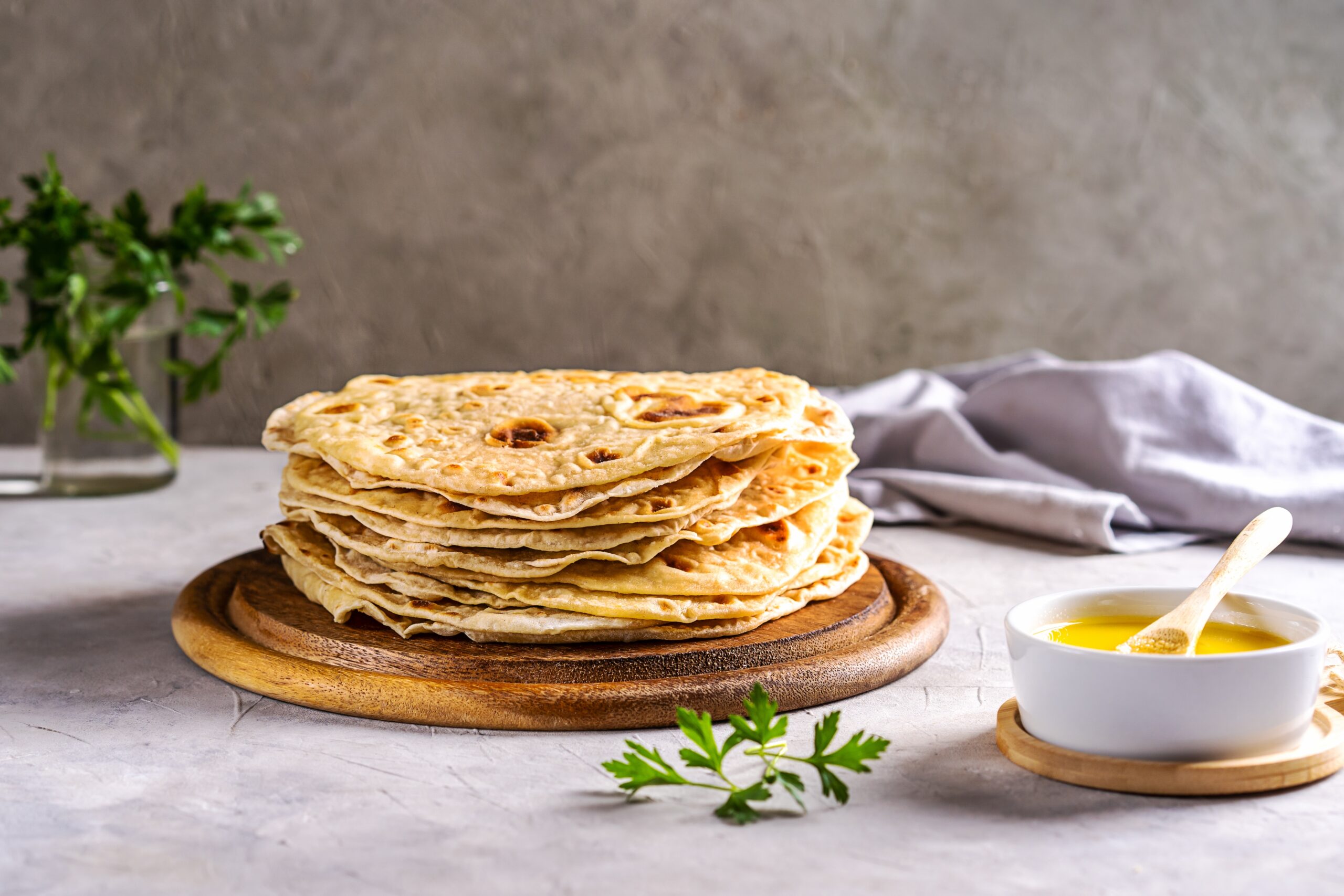
Quick and Easy Whole Wheat Chapati Recipe
Click here for a printable copy of this recipe.
- Doshic Effect: Vata ↓, Pitta ↓, Kapha ↓↑*
- Makes: 8 chapati
- Prep Time: 15 to 20 minutes
- Cook Time: 10 minutes (about 1 minute per chapati)
*Balanced Kapha types can enjoy this recipe on occasion and in moderation; this recipe will increase Kapha in excess.
Materials
- 12-inch cast iron griddle (substitute with any large non-stick skillet pan) *I love my Lodge Cast Iron Griddle!!
- Chapati rolling pin (substitute with any rolling pin)
- Measuring spoons and cups
- Medium to large mixing bowl
- Mixing spoon
- Spatula
- Chapati/tortilla warmer (optional but recommended)
*All Amazon links are affiliate-based but recommended with care. By ordering directly through these links you can help support Svastha Ayurveda!
Ingredients
- 2½ cups 100% whole wheat flour
- 1 cup warm water
- 1 tablespoon melted ghee (substitute with olive oil)
- ¾ teaspoon pink Himalayan salt
*All Amazon links are affiliate-based but recommended with care. By ordering directly through these links you can help support Svastha Ayurveda!
Directions
Click here for a printable copy of this recipe.
1. Blend the salt and flour evenly together in a medium to large mixing bowl.
2. Add ¾ cup of warm water and the ghee and stir together; make sure all of the dry flour gets mixed in. Add more water by the tablespoon if the dough seems too dry. Ideally, you are aiming for a moist dough that is not sticky, or crumbly. If the dough is sticking to your hands, more flour can be added. If the dough is not able to hold a ball form without cracking, a small amount of water can be slowly added in.
3. Once you have found the perfect texture, knead the dough for 3 to 5 minutes.
4. Cut the dough into 8 even sections. This amount will get you about 8-inch-sized chapatis. If smaller ones are preferred increase the amount of sections.
5. Roll each section into a ball.
6. Lightly flour a clean countertop for rolling out the dough. Place one dough ball on the sprinkled flour and roll it out using a small rolling pin or chapati roller.
7. To get a circular shape, move the dough around in a clockwise direction as you evenly roll out all sides. The final chapati dough should be very thin, similar to the thinness of a tortilla. The shape may not be a perfect circle but do not worry. It will taste just as delicious no matter the shape:)
8. Once you are about halfway done with the rolling, heat an ungreased large griddle or 12-inch skillet over medium-high heat. If a cast iron pan is available this is preferable. For even cooking, it is recommended to use a large burner that covers most of the pan.
9. After rolling out all the balls, place one on the heated griddle or skillet. Make sure all of the edges are lying flat against the pan.
10. Cook the first side for 15 to 30 seconds or until bubbles start to form in the dough.
11. Flip over and cook for another 15 to 30 seconds. Then flip one last time and cook for a final 15 to 20 seconds. If the cooked chapati is hard or rubbery, you are likely cooking too long. They should be soft and flexible.
12. Place the finished chapati in a chapati warmer (best!) or on a large plate (cover with a dish towel); repeat steps 9 to 11 with the remaining uncooked chapatis.
13. Chapatis are best when eaten immediately for the most softness and freshest flavor. However, they will keep for up to 2 to 3 hours by storing them in a chapati warmer or by covering them tightly with foil and storing them in an unheated oven. If you need to keep them for longer, see the storage tip below.
Storage & Reheating Tips
Chapati is best eaten freshly cooked or within 2 to 3 hours when in a chapati/tortilla warmer or wrapped in foil and placed in a warm oven.
When needed, chapati can be stored in the freezer to be reheated. For this, wrap each one individually in plastic wrap. Then store them in a ziplock bag or airtight tupperware and place them in the freezer for up to 3 months. To reheat, place the frozen chapati in the refrigerator for several hours to thaw. Then heat a frying pan over a medium-high setting and heat each side for 10 seconds or until warm. Serve immediately.
Optional Ingredient Tips
If you are feeling daring, try adding a bit of spice to your chapati flour. Some tasty options are ½ to 1 teaspoon of Agni Churna or ¼ teaspoon of turmeric, ½ teaspoon of cumin, and a dash of black pepper. Other ingredients such as minced cilantro or green chili can be added too. Play around a bit and see what recipes you can discover!
Complimentary Recipes
- Best Basic Hummus Recipe
- Coconut Cilantro Chutney
- Spicy Turmeric & Ginger Pickle
- Tridoshic Red Lentil Dal
- Classic Cleansing Kitchari
- Vata-Reducing Kitchari Recipe
- Pitta-Reducing Kitchari Recipe
- Spicy Dal and Peppered Rice Recipe
- Dairy-Free Spinach Saag Recipe
- Spicy Spinach, Kale, And Cauliflower Curry
- Cooling Coconut and Kale Sauté
- Black Eyed Peas and Kale Rice Bowl
- Chickpea and Greens Brown Rice Bowl
Try my Agni Churna spice blend!
Discover more healing recipes with my 30-Minute Ayurvedic Cookbook!

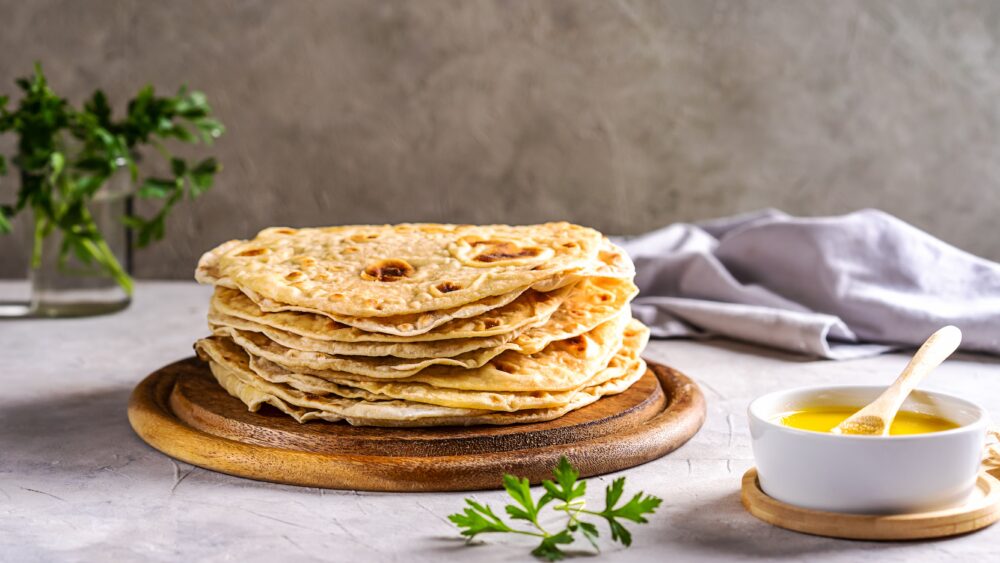
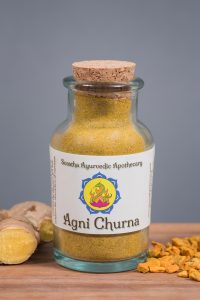
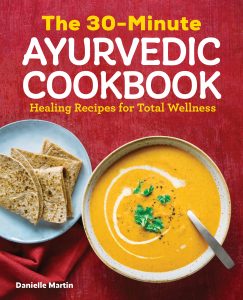

When is the ghee or olive oil added to the recipe for chapati?
Hi Carmela,
Thank you for bringing this to my attention! It seems like I forgot to add this to the instructions. I will update this now!
You can add in the oil or ghee at the same time as the water and blend them in evenly with the dry ingredients.
I hope you enjoy the chapati as much as I do!
Namaste,
Danielle